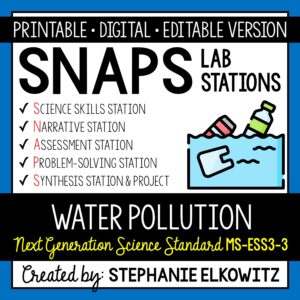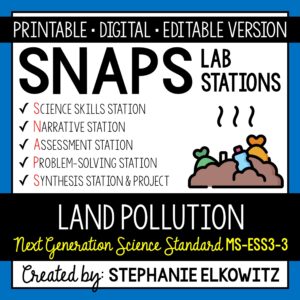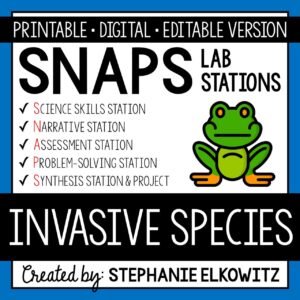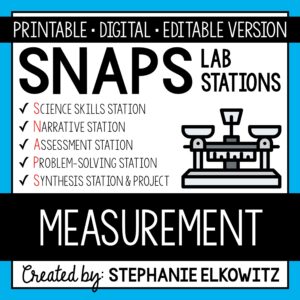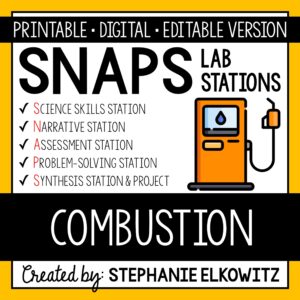MS-ESS2-2 Water’s Role in Shaping Earth Lab
$7.00
An engaging lab activity designed to enhance students’ understanding of how water changes Earth’s surface. Aligned with NGSS MS-ESS2-2.
Description
MS-ESS2-2 Water’s Role in Shaping Earth Lab Preview
SNAPs Lab Stations Activities require students to use science, math, literacy, problem-solving and engineering skills. They are designed to enhance students’ understanding of scientific concepts and help students apply scientific ideas to the real world. Each station activity promotes skills so to develop students into proficient and competent scientific thinkers.
SNAPs lab activities have five components:
• Science Skills Station to develop science skill proficiency
• Narrative Station to build science literacy
• Assessment Station to evaluate learning and understanding
• Problem-Solving Station to foster engineering design
• Synthesis Station and Project to inspire higher-order learning
DIGITAL LABORATORY – DISTANCE LEARNING & DIGITAL CLASSROOMS
• This lab is offered in a digital format to support digital classrooms & distance learning.
• The digital lab activity is designed to work with Google Slides and Microsoft PowerPoint
• The digital lab activity CANNOT be edited. However:
– Students can manipulate text boxes
– Students can create tables, graphs and diagrams
– Students can insert images and drawings
GOOGLE FORM ASSESSMENT STATION
• The assessment station is offered as a self-grading Google Form.
• Questions are all short answer and are 100% editable.
• Suggestions for use are included in the download.
DISTANCE LEARNING COMPATIBILITY
SNAPs lab activities are rated for their ease with distance – independent learning. Refer to the preview for more information about how well this laboratory works in a fully digital classroom and with distance learning.
EDITABLE DOCUMENTS
This download includes an editable word document (docx file) of all lab components:
• Pre-Lab and Post-Lab Activities
• The Lab Overview
• Lab Station Activities and Questions
• Directed Synthesis Project (when applicable)
Important Notes:
• Diagrams, illustrations, tables and graphs essential to lab activities are included
• Illustrative clipart is NOT included
• Editable documents and rubrics are included with the FREE SNAPs Setup Guide
Editable files allow you to:
• Edit the scope of the activities so to suit your students’ needs
• Edit the materials required based on resource availability
• Create single-period “mini-labs” using activities at the individual skills stations
The activities at each station in this lab are detailed below.
Water’s Role in Shaping Earth Lab Stations Activity Learning Objectives
1. Make observations of how water changes Earth’s surface with a stream table.
2. Interpret and analyze data to describe water’s role in weathering, erosion and deposition of sediment in a river.
3. Identify factors that cause the deposition of sediment in a river.
4. Explain patterns of erosion and deposition in a river.
5. Design a solution that controls erosion due to flooding.
6. Construct a prototype that controls erosion due to flooding.
Science Skills Station
Students will make observations (directly or indirectly with videos) of water moving through a meandering river in a stream table. Students will also interpret and analyze data in a Hjulströms diagram to understand how velocity and sediment size affect how a river weathers, erodes and deposits sediment in the bed of the river. Students will make predictions about how moving water changes the landscape.
Narrative Station
Students will watch a video about how water shapes Earth’s surface. Then students will read a passage about factors that influence the deposition of sediment in a river. If time allows, students will watch a second video about how moving water in a river changes the shape of that river.
Assessment Station
At this station, students will answer questions about key terms and ideas relating to water’s role in weathering, erosion and deposition. Students must employ lower, mid and higher order thinking skills to answer these questions.
Problem-Solving Station
Students will develop a solution that minimizes problems associated with river flooding or storm surge. The solution should consider the rapid change that water can cause when flooding occurs. Then students will construct a prototype of that solution to show how and where it will be built relative to a river or beach.
Synthesis Station
Students will compose a CER (claim-evidence-reasoning) report to summarize the lab. Students are provided the claim statement and must support the claim with observations, data and other information gathered in the lab. Students will explain how the evidence supports the claim using scientific reasoning.
Synthesis Project
Students will have a choice of 11 projects. Refer to the SNAPs Lab Stations Best Practices and Setup Guide for directions and suggestions on how to conduct the project.
This download includes:
• A pre-lab assignment and post-lab reflection
• Directions and questions for each lab station
• Student recording sheets
• Teacher Key
Additional Materials Required:
2-3 Computers or tablets
Stream table (optional)
50 pound bag of mineral sand (optional)
Ten small pebbles (approximately 1cm diameter) (optional)
One large pebble or rock (approximately 5 cm diameter) (optional)
Food coloring (optional)
Poster board or foamboard (no more than 12” x 12”) (1 per group)
White air-dry modeling clay (Crayola™ Model Magic) (approximately 8 oz per group)
Markers
Toothpicks
Tape, scissors and glue
LINKS TO VIDEOS
This laboratory requires internet to access videos. Videos are hosted on SafeShare.TV so to safely watch and share educational YouTube videos without ads, comments and other distractions. Link(s) to SafeShare.TV included. Full link to original YouTube video(s) included.
NEXT GENERATION SCIENCE STANDARDS
This laboratory satisfies NGSS MS-ESS2-2. It combines the three dimensions of science learning – science and engineering practices, disciplinary core ideas and crosscutting concepts – to meet the standard. This lab also makes interdisciplinary connections to STEM, Math CCSS and ELA CCSS to build the appropriate skills.
TERMS OF USE
• All rights reserved by Stephanie Elkowitz.
• This product is to be used by the original purchaser only.
• Intended for classroom and personal use only.
• Copying for more than one teacher, classroom, department, school, or school system is prohibited.
• This product may not be distributed or displayed digitally for public view.
• Failure to comply is a copyright infringement and a violation of the Digital Millennium Copyright Act (DMCA).




